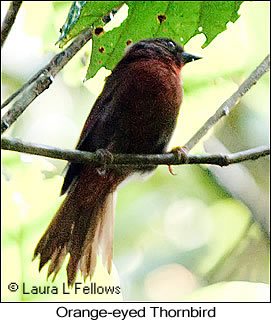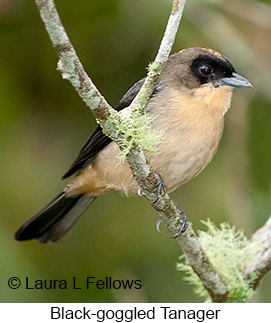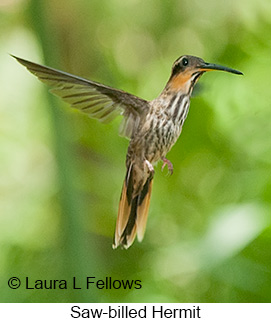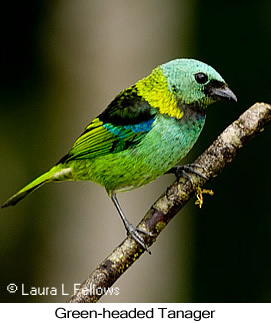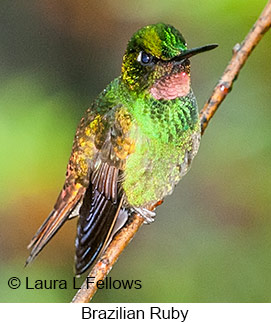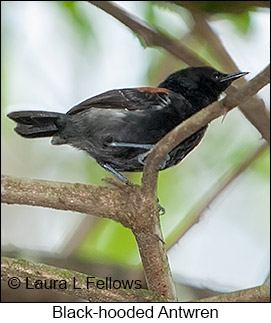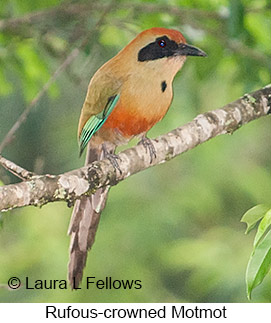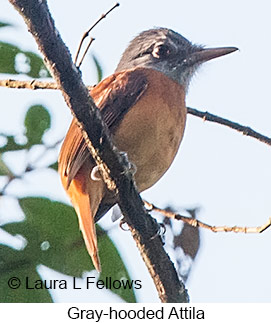SE ATLANTIC FOREST EXTENDED TOUR
Tour Description

BRAZIL
BIRDING TOUR
ANY TIME*
| Duration: | 19 days, 18 nights |
| Group Size: | 2-8 |
| Anytime Price: | $9500 |
| Group Price: | $9200 |
| Single Suppl: | $600 |
| Est #Species: | 400-450 |
| Pace: | Easy/Moderate |
| Difficulty: | Easy/Moderate |
| * This tour is available for any dates of your choosing provided guide services and accommodations are available. | |
DAY 1 - OVERNIGHT FLIGHT
Overnight flight to Curitiba via Sao Paulo (not included in tour price).
DAY 2 - TRANSFER & ITAPOA
Arrive at Curitiba's international airport no later than noon. Transfer 3½ hours to Guaraquecaba, stopping for lunch en route. There should be time to look for Marsh Antwren near Itapoa not far south of Guaraquecaba. Night at Pousada do Bigua.
DAY 3 - SALTO MORATO RESERVE
Morning and afternoon birding in the reserve. The two trails open to the public around the main buildings allow good birding in lowland Atlantic Forest. Lunch at the pousada, half an hour from the reserve. Among the many birds of interest are Yellow-legged Tinamou, Black-and-white Hawk-Eagle, White-necked Hawk, Pavonine Cuckoo, Scissor-tailed Nightjar, Rusty-breasted Nunlet, Brown-backed Parrotlet, Scaled Antbird, Black-cheeked Gnateater, Scalloped Woodcreeper, Sharp-tailed Streamcreeper, Olive Spinetail, Restinga Tyrannulet, Blue-billed Black-Tyrant, Rufous-tailed Attila, Black-headed Berryeater, Azure Jay, Chestnut-headed Tanager, Gray-throated Warbling-Finch, and Ultramarine Grosbeak. Night at Pousada do Bigua.
DAY 4 - SUPERAGUI NATIONAL PARK
All day boat trip to bird the marine estuary and Superagui National Park. The park encompasses coastal forests, Ilha do Superagui, and other small islands off the coast and supports coastal ecosystems such as beaches, mangroves, and Atlantic Forest. A key target species seen there is the Red-tailed Parrot, listed as Vulnerable by the IUCN. Other possibilities include King Vulture, Rufous Crab Hawk, Collared Plover, Brown-hooded Gull, and Snowy-crowned Tern. Night at Pousada do Bigua.
DAY 5 - TRANSFER & CARLOS BOTELHO STATE PARK
Depart after early breakfast for Intervales State Park, a 6½ hour drive to the north. En route stop for some birding at Carlos Botelho State Park for some birding. Arrive at Intervales in late afternoon. Night in Intervales State Park.
DAY 6 - INTERVALES STATE PARK
Intervales State Park offers perhaps the best birding in all of southeast Brazil. This fabulous, yet often not visited park, is simply incredible. Birding is mainly along roads in the park, but some birding is along mostly flat trails into forested areas. Three full days in the park is well worthwhile.
Early birding around the lodge and a nearby short trail can be very productive. A key target species is Serra do Mar Tyrant-Manakin. This species is often seen from the road outside the cabanas. Another species often seen near the rooms is Large-tailed Antshrike. The trail from the lodge goes through good forest and gets steeper near the top, entering cloud forest where Shear-tailed Gray Tyrant and Bare-throated Bellbird are likely. Among the many other possibilities are Brown Tinamou, Gray-headed Kite, Giant Antshrike, Orange-eyed Thornbird, Atlantic Royal-Flycatcher, Hooded Berryeater, Cinnamon-vented Piha, and Wing-barred Piprites.
After lunch bird primary forest along the Carmo Road. A trail off the road offers the possibility of seeing Purple-crowned Plovercrest displaying on a lek. Along the road birds such as the endemic Black-fronted Piping-Guan and the difficult Crescent-chested Puffbird are possible. Night in Intervales State Park.
DAY 7 - INTERVALES STATE PARK
Morning bird the Lageado Trail. The trail goes through secondary and primary foest and for a short distance past an open marshy area. On the way there a stop by the resident guide's cabin may produce the much sought-after Half-collared Sparrow. Possibilities include Helmeted Woodpecker, Rufous-breasted Leaftosser, Lesser Woodcreeper, Sao Paulo Tyrannulet, Oustalet's Tyrannulet, Eye-ringed Tody-Tyrant, Gray-headed Tody-Flycatcher, Bearded Flycatcher, Whiskered Flycatcher, Bare-throated Bellbird, Swallow-tailed Manakin, and Black-goggled Tanager.
After lunch bird an open area near the research station where possibilities include Blackish Rail in a marshy wetland, the quite rare Blue-bellied Parrot, Tufted Antshrike, Brown-breasted Pygmy-Tyrant, and more. After dark night birds such as Rusty-barred Owl, Stygian Owl, Silky-tailed Nightjar, and Long-trained Nightjar are possible. Night in Intervales State Park.
DAY 8 - INTERVALES STATE PARK
Morning return to Carmo Road to look for species missed previously. Later in the morning climb some steep steps to the chapel where Red-ruffed Fruitcrows are often seen. After lunch bird the trail near the research station again, looking for new species not seen earlier. Night at Intervales State Park.
DAY 9 - INTERVALES & UBATUBA
Morning birding around the lodge area. After breakfast transfer to Ubatuba, a five hour drive. A half hour before arrival, stop at the private Guainumbi Reserve to view hummingbirds and other species coming to feeders. Typical hummingbirds appearing at feeders include Black Jacobin, Saw-billed Hermit, Scale-throated Hermit, Swallow-tailed Hummingbird, White-vented Violetear, Amethyst Woodstar, White-throated Hummingbird, and Sapphire-spangled Emerald. Other likely species include Plain Parakeet, Scaly-headed Parrot, Green-headed Tanager, and Golden-winged Cacique . Arrive at hotel around dark. Night at Hotel Solar das Aguas Cantantes.
DAY 10 - SERRA DO MAR STATE PARK AREA & FINCA ANGELIM
Early breakfast and then drive 20min to Serra do Mar State Park. Spend morning there. Likely species include White-tailed Trogon, Tufted Antshrike, Spot-breasted Antvireo, White-shouldered Fire-eye, Rufous-capped Antthrush, Orange-breasted Thornbird, Gray-headed Tody-Flycatcher, Yellow-browed Tyrant, Lemon-chested Greenlet, Masked Yellowthroat, Chestnut-bellied Seed-Finch, and Red-rumped Cacique. After lunch in town, visit Finca Angelim on the outskirts of town. The open forest around the farm buildings and the trail into secondary forest offer excellent birding. Key target birds there include Spotted Bamboowren, Slaty Bristlefront, and Buff-throated Purpletuft. Other possibilities include Spot-backed Antshrike, Star-throated Antwren, Salvadori's Antwren, Slaty Bristlefront, Pin-tailed Manakin, White-bearded Manakin, Crested Becard, Long-billed Gnatwren, Flame-crested Tanager, and Brazilian Tanager. Night at Hotel Solar das Aguas Cantantes.
DAY 11 - UBATUBA AREA
Morning depart after breakfast for Folha Seca, about 20min south of town. The trail is basically a flat jeep track into secondary forest. Along the way is Mr. Jonas's feeders, which attract numerous hummingbirds. Among them are Saw-billed Hermit, Black-throated Mango, Festive Coquette, Brazilian Ruby, Violet-capped Woodnymph, Sombre Hummingbird, Versicolored Emerald, Glittering-throated Emerald, and White-chinned Sapphire. His fruit feeders attract species such as Ruby-crowned Tanager, Brazilian Tanager, Azure-shouldered Tanager, Green-headed Tanager, Purple-throated Euphonia, and Chestnut-bellied Euphonia. After lunch visit Finca Carpricornio on the north side of town. Possibilities there include Solitary Tinamou, Ochre-collared Piculet, Yellow-throated Woodpecker, White-browed Foliage-gleaner, Sao Paulo Tyrannulet, White-throated Spadebill, and Black-capped Becard. Night at Hotel Solar das Aguas Cantantes.
DAY 12 - TRANSFER & ITATIAIA NATIONAL PARK
Depart after breakfast for Itatiaia National Park via Pereque farther up the coast where a stop outside town usually produces the endangered Black-hooded Antwren. Shortly before arriving at the hotel inside the park, a wetland stop may produce Short-tailed Hawk, Green-barred Woodpecker, White-eyed Parakeet, Spix's Spinetail, Streamer-tailed Tyrant, and Cinnamon Tanager. After check-in view feeders near the hotel. Frequent visitors include Frilled Coquette, Brazilian Ruby, White-throated Hummingbird, Saffron Toucanet, Brown Tanager, Olive-green Tanager, Golden-chevroned Tanager, Green-headed Tanager, Blue-naped Chlorophonia. In addition, Dusky-legged Guans and Red-breasted Toucans are usually readily seen around the lodge grounds. Night at Hotel do Ype.
DAY 13 - ITATIAIA NATIONAL PARK
Early breakfast then bird Tres Pecos Trail near the lodge. This trail provides access to the forest interior. A key target species is the difficult tapaculo Slaty Bristlefront. Other good possibilities include Spot-billed Toucanet, Yellow-fronted Woodpecker, White-bearded Antshrike, Rufous-tailed Antbird, Rufous Gnateater, Black-billed Scythebill, White-collared Foliage-gleane, Pale-browed Treehunter, Fork-tailed Pygmy-Tyrant, Large-headed Flatbill, Greenish Schiffornis, and Brown Tanager. After lunch bird some trails near the lodge looking for Scale-throated Hermit, Rufous-capped Motmot, Lineated Woodpecker, White-throated Tapaculo, Sepia-capped Flycatcher, Velvety Black-Tyrant, Long-tailed Tyrant, Swallow-tailed Cotinga, and Yellow-legged Thrush. Night at Hotel do Ype.
DAY 14 - ITATIAIA NATIONAL PARK
Depart early for the northern, higher elevation section of the park, an area called Agulhas Negras. An initially paved road up into this area turns into a dirt track and eventually an open trail into the highlands. The birding there is tremendous. Among the many new birds likely there are Surucua Trogon, White-spotted Woodpecker, Robust Woodpecker, Rufous-winged Antwren, Bertoni's Antbird, Speckle-breasted Antpitta, Mouse-colored Tapaculo, Buff-fronted Foliage-gleaner, Araucaria Tit-Spinetail, Itatiaia Spinetail, Pallid Spinetail, Ochre-faced Tody-Flycatcher, Grayish Mourner, Black-and-gold Cotinga, Black-capped Piprites, White-browed Warbler, Diademed Tanager, Burnished-buff Tanager, Brassy-breasted Tanager, Bay-chested Warbling-Finch, and Green-winged Saltator. Night at Hotel do Ype.
DAY 15 - TRANSFER & GUAPI ASSU
After breakfast transfer to Guapi Assu (Regua), arriving for late lunch. Afternoon viewing hummingbirds coming to feeders and birding the wetlands area below the lodge. Likely hummingbirds include Black Jacobin, Saw-billed Hermit, Planalto Hermit, Rufous-breasted Hermit, Swallow-tailed Hummingbird, Versicolored Emerald, White-chinned Sapphire, and Glittering-throated Hummingbird. Around the wetlands possibilities include White-faced Whistling-Duck, Muscovy Duck, Brazilian Teal, Masked Duck, Capped Heron, Whistling Heron, Ash-throated Crake, White-barred Piculet, Yellow-eared Woodpecker, Chestnut-backed Antshrike, Southern Antpipit, Moustached Wren, and Chestnut-vented Conebill. Night at Guapi Assu Lodge.
DAY 16 - GUAPI ASSU
Most of day birding Waterfall Trail, probably only as far as the waterfall. The trail is fairly easy the first 2½ miles to the waterfall and then becomes steeper and more difficult the next 2 miles. This is one of the birdiest trails in the reserve and can keep us busy all day. The first section of trail goes through secondary forest and is a good place to find White-rumped Tanager, a likely split from Turquoise Tanager. The bamboo section of the trail beginning about ½ mile from the start is the traditional place to find the endemic Slaty Bristlefront. The section between posts 1350m and 1400m (about ¾ miles) is the best place to find the prized Shrike-like Cotinga. Other possibilities include Red-breasted Toucan, White-browed Woodpecker, Spot-backed Antshrike, White-flanked Antwren, White-bibbed Antbird, Rufous-breasted Leaftosser, White-throated Woodcreeper, Black-capped Foliage-gleaner, Ochre-bellied Flycatcher, Southern Antpipit, Eye-ringed Tody-Tyrant, Bare-throated Bellbird, Brassy-breasted Tanager, and Yellow-green Grosbeak. Late afternoon return to the wetlands area below the lodge. At dusk look for Least Pygmy-Owl. Night at Guapi Assu Lodge.
DAY 17 - PICO DA CALEDONIA
Depart after early breakfast for the one hour drive to Nova Friburo. Near the town is Pico da Caldonia, a high altitude site within Tres Picos State Park best known as the most reliable place to see Gray-winged Cotinga. It can sometimes take quite a while to find this rare species, and other times a person can get lucky early on. Plenty of time is allowed to pick this bird up. Other possibilities include White-rumped Hawk, White-collared Swift, Gray-rumped Swift, Red-capped Parrot, Variegated Antpitta, Such's Antthrush, Plain-winged Woodcreeper, Olivaceous Elaenia, Highland Elaenia, Bearded Flycatcher, Whiskered Flycatcher, Shear-tailed Gray Tyrant, Gray-hooded Attila, and Sharpbill. In late afternoon look for Scissor-tailed Nightjar and Giant Snipe along roadsides. Night at Guapi Assu Lodge.
DAY 18 - GUAPI ASSU &: RIO DE JANEIRO
Morning birding near lodge targeting any species missed previously. Afternoon transfer to Rio de Janeiro. End of tour at the airport. Overnight flight home.
DAY 19 - FLIGHT HOME
International flight home.
ADDITIONAL INFO
(Not on Menu Above)
BIRDING LOCALES
